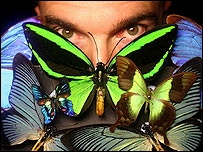Butterfly wings work like LEDs
When scientists developed an efficient device for
emitting light, they hadn't realised butterflies have been using the same method
for 30 million years.

When scientists developed an efficient device for emitting light, they hadn't realised butterflies have been using the same method for 30 million years.
Fluorescent patches on the wings of African swallowtail butterflies work in a very similar way to high emission light emitting diodes (LEDs).
------------
In 2001, Alexei Erchak and colleagues at the Massachusetts Institute of Technology (MIT) demonstrated a method for building a more efficient LED.
------------
Pete Vukusic and Ian Hooper at Exeter have now shown that swallowtail butterflies evolved an identical method for signalling to each other in the wild.
------------
"Unlike the diodes, the butterfly's system clearly doesn't have semiconductor in it and it doesn't produce its own radiative energy," Dr Vukusic told the BBC News website "That makes it doubly efficient in a way.
"But the way light is extracted from the butterfly's system is more than an analogy - it's all but identical in design to the LED."
It’s ain’t bad to see scientists in completely unrelated disciplines keeping up with each other’s work, either.
Posted: Fri - November 18, 2005 at 12:42 PM